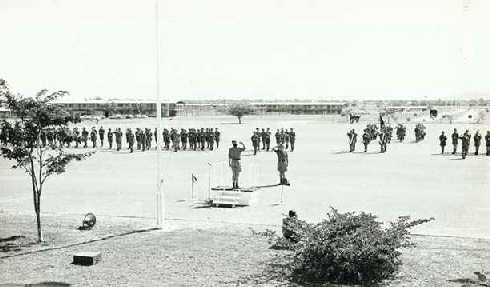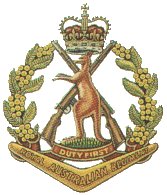 |
|
| Raised | Linked on 15 Aug 1973 Unlinked 1 Feb 1995 | ||
| Battalion colour |
Black ( BCC 220) |
& Scarlet (BCC 209) | |
| Battalion nickname | |||
| Battalion march |
Ringobrackie |
||
| Current home | Not on ORBAT. | ||
 With
the reorganisation of the Army during 1973 due to the cessation of
National Service, 2 RAR and 4 RAR were linked on 15 Aug 73, to form the
2nd/4th Battalion, The Royal Australian Regiment. With
the reorganisation of the Army during 1973 due to the cessation of
National Service, 2 RAR and 4 RAR were linked on 15 Aug 73, to form the
2nd/4th Battalion, The Royal Australian Regiment.
The Battalion was formed up on the parade ground by the RSM, WO1 W.T.C. Thompson. The 2nd Battalion was marched back to the rear lines were 4 RAR resided and the RSM handed over to WO1 Ken Hall. The new 2nd/4th Battalion was lead off the parade ground by the Pipe Major WO2 D. Torenson to the tune of ‘Inverbrackie’ and ‘Ringo’. Through the next twenty years of history the Battalion enjoyed training in a peacetime army and achieved many successes on the sporting field and in competitions, such as, Duke of Gloucester Cup and South East Asia Sniper team competitions. The new Battalion was charged with the task of preserving the traditions, associations, museums and proprietorship of the two original battalions from which it was formed until such time as the linking is annulled. Because of this, all ranks of 2/4 RAR were aware of the history of both 2 RAR and 4 RAR and jealously preserved these traditions, whilst working hard to establish a distinctive image for their Battalion. Between 1977 and 1979 the Battalion concentrated on conventional warfare including night and mounted operations. On 1 Jul 80, the unit was re-organised on fight scales and trained as part of the Operational Deployment Force (ODF) in close country and conventional warfare operations. On 1 Feb 82, with the official replacement of the title 'Task Force' with 'Brigade', 2/4 RAR became a unit of the 3rd Brigade, 1st Division. The Battalion was placed on operational readiness in 1987 and 1990. On each occasion the Battalion was prepared to evacuate Australian citizens from Pacific region countries experiencing civil disturbance. From 1990 to 1993 many individual soldiers from the Battalion served with the United Nations in Cambodia. In 1993, 54 soldiers from the Battalion were detached to 1RAR for operational service in Somalia as part of Operation Solace. In May 93, 2/4 RAR was tasked to provide a Rifle Platoon for Operation Gemini in Cambodia. 12 Platoon Delta Coy, deployed to Cambodia tasked with providing local security for Australian Army Aviation Assets.
It was during the Battalion's deployment to Rwanda on Operation Tamar in 1994, that the Government made the decision to unlink the 2nd/4th Battalion. This was a result of the 1994 Defence White Paper that identified the need for an additional Infantry Battalion to enhance the Army's capability to meet strategic guidance requirements. On 15 Jan 95, LTCOL R.C. Smith who was posted to Land Headquarters and had carried out the detailed planning to raise the Battalion, was appointed Commanding Officer of 4 RAR. A Project Team for the raising of the additional infantry battalion was formed on 23 Nov 94, to begin planning. This consisted initially of the CO, LTCOL R.C. Smith and RSM, WO1 K.R. Kahler. Shortly afterwards additional personnel with future appointments in the Battalion were posted to the Project Team. The Courts Martial Room at Land Headquarters, Victoria Barracks, Paddington along with numerous computers and mobile phones, were made available for the Project Team to commence work. This was the beginning of the new technology Battalion. Manning was approved for 69 ARA and 103 GRes soldiers in the first year, building to 3 ARA rifle companies and 1 GRes rifle company by 1998. The General Reserve would also have proportional elements in Support and Admin Companies giving respective strengths of 556 ARA and 150 GRes. Therefore, the total unit strength would be 706. The 2nd/4th Battalion was unlinked by the Chief of the General Staff, LTGEN J.C. Grey, AO on a parade at Samichon Lines, Lavarack Barracks, Townsville at 1500 hrs on 1 Feb 95. Copyright; Department of Defence |

 In
Aug 94, 114 members of the Battalion mainly A Coy deployed to Rwanda as
part of the Australian Medical Support Force for the United Nation
mission UNAMIR II. The nucleus of the 2/4 RAR contingent was Alpha
Company, tasked to provide security for the Australian Medical Support
Force. Other 2/4 RAR personnel were employed in the Contingent
Headquarters, as medical assistants and in logistic support functions.
In
Aug 94, 114 members of the Battalion mainly A Coy deployed to Rwanda as
part of the Australian Medical Support Force for the United Nation
mission UNAMIR II. The nucleus of the 2/4 RAR contingent was Alpha
Company, tasked to provide security for the Australian Medical Support
Force. Other 2/4 RAR personnel were employed in the Contingent
Headquarters, as medical assistants and in logistic support functions.